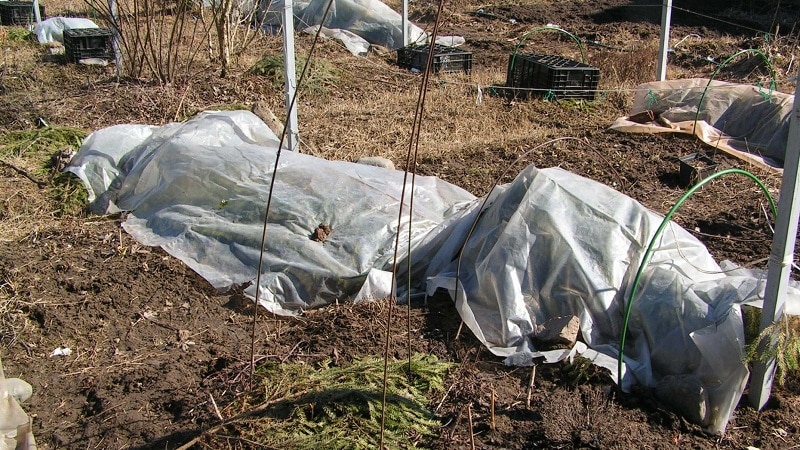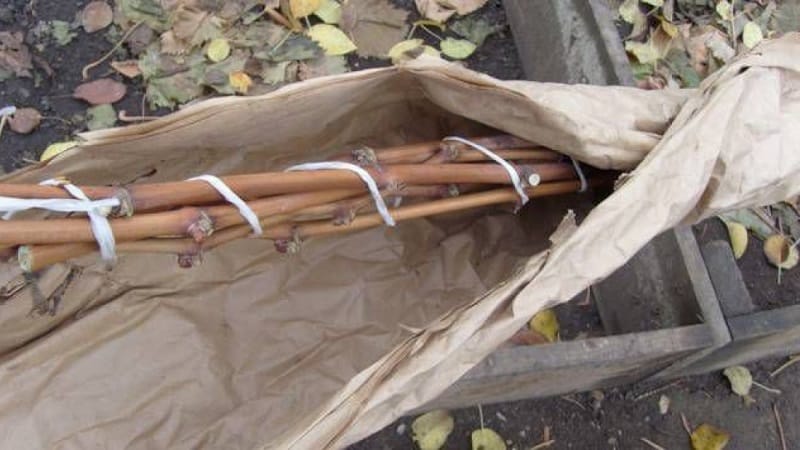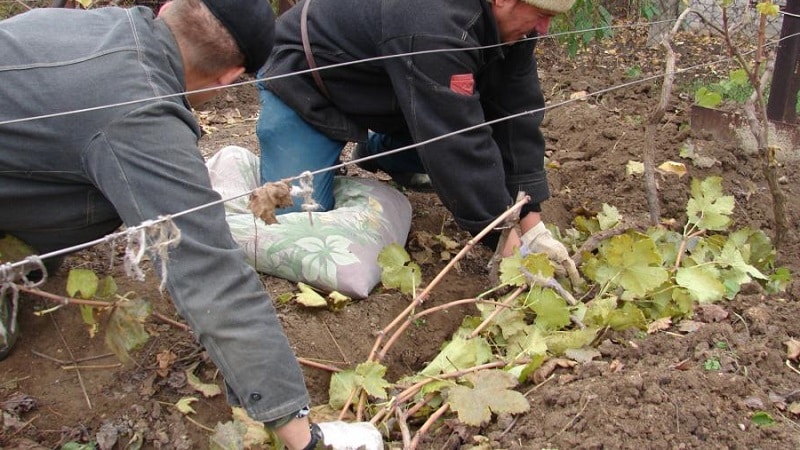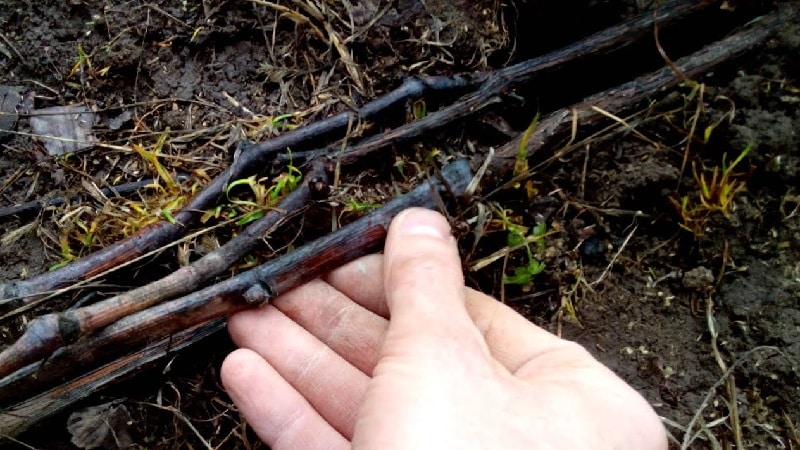How and when to open grapes after wintering
Beginning winegrowers and summer residents often wonder when and how to open grapes after wintering. Specific timing and methods depend on climatic and weather conditions, plant variety, shelter method and other factors. In spring, it is important to properly care for the crop, treat it against diseases and protect it from return frosts.
When to open grapes after winter
Grapes are not a greenhouse crop, so they do not wait until warm weather sets in. Before sap flow begins, most varieties can withstand temperatures down to -4°C.
Here it is important to protect the developing buds from recurrent frosts: they die at the slightest drop in temperature below 0°C. The grapes are opened only after the snow has melted and the soil has dried out.

Calendar dates
Specific timing of grape opening varies by region. On average, this is the first ten days of April, but at different latitudes the period ranges from mid-March to the end of May. In general, they rely on weather conditions.
Optimal weather conditions
Open the bushes on a clear sunny day, allow the vine to ventilate and dry properly. Precipitation on opening day is highly undesirable, but spring weather is difficult to predict. Therefore, using the forecast of weather forecasters, gardeners choose a period of 3-4 days when precipitation is not planned.
If the winter was snowy and the snowdrifts do not leave the area, 2 weeks before the procedure Carefully clear away the snow that has accumulated on the shelter.In this case, the soil will dry out faster. The material itself is removed when the threat of frost completely disappears.
In some regions in the spring there are differences in daily temperatures from +15°С to -5…-7°С. In order not to destroy the waking vine during this period, the plants are opened for the day, and in the evening they are again insulated with film or other material.
Important! If the average daily air temperature is +10°C, the grapes are opened in full mode, since the buds will begin to grow anyway.
Depending on the growing region
In the conditions of the Volga region and the middle zone the shelter is removed in the first ten days of May. Mature bushes that have survived at least 4 winters open in late April - early May.

Optimal timing:
- in southern latitudes - the first ten days of April;
- in Crimea - late March - early April;
- in the northern regions - mid - end of May.
In the Urals frosts sometimes return even in June–July. This does not mean that local gardeners do not open their grapes all spring: in a short summer, this does not make sense.
All spring events are carried out as usual, but non-woven material or film is kept ready for prompt insulation of the vine in case of cold weather.
Interesting things on the site:
A guide to properly preparing grapes for winter
How should grapes be planted in the fall?
Why do you need to prune grapes in the fall and how to do it?
Why is it important to remove the shelter on time?
Many gardeners consider return frosts to be the main problem when opening grapes, so they remove the material later. This is an erroneous position, since the lack of sunlight will not be an obstacle to the growth of shoots.
As soon as the temperature around the bush reaches +10°C, the buds will begin to wake up right in the shelter. After belated removal, the stems on the overwintered vine will be weak and pale from lack of sun. If they are not shaded, the leaves will immediately get sunburn, and such shoots are not viable. To save them, additional canopies are built from the sun's rays, and the plant gradually adapts to the light.

When removing vines with already awakened buds from the shelter and fragile shoots have a high risk of damaging them.
Attention! Be careful and attentive when using film as a covering material: it creates a greenhouse effect and a favorable environment for the growth of mold.
How to properly remove a shelter
Methods for freeing bushes from winter insulation are used depending on the covering method used:
- If the grapes have been hilled, carefully rake away the soil so as not to damage the root part of the vine. Level the layer of mulch between the rows and mix it with the soil: this will speed up decay and feed the plant, weakened after winter. The soil is loosened with a rake to provide oxygen access to the roots.
- When using partial or complete cover, the bushes are freed from mats, film, burlap and the vines are carefully cleared of the soil. Experienced winegrowers harden off the bushes by making several holes in the material, but do not remove it until warm weather sets in. Experienced winegrowers do not rush to tie up the vines - for now it is enough to simply lay them out on the ground and let them dry.
- If there is a risk of the night temperature dropping to below zero, the plants are insulated with spruce branches or pine needles at night. Agrofibre is suitable: it is thrown over the bush and the edges are secured.
If no precipitation is expected, after opening the vine is left for 2-3 days., then carefully tied up, cutting and forming bushes at the same time. This garter is called dry: it is carried out before the juice begins to move, until the buds begin to swell.
How to care for grapes after opening
After removing the insulation, a number of measures are carried out to maintain plants after wintering: they trim the bushes, remove damaged shoots, thin out and shape the vine, treat the grapes for diseases and fertilize them.
What to process
Even before the buds awaken, the vine is treated against fungal diseases, especially mildew and oidium.:
- A 2% solution of copper sulfate has proven itself well. To prepare the composition, dilute 200 g of the drug in 10 liters of water. The product is filtered through a thick sieve or gauze so as not to clog the spray nozzle. Spray the vine with a spray bottle and allow it to dry naturally. The procedure is carried out in calm, dry weather at an air temperature of at least +5°C.
- During the same period, during deep digging, nitrogen fertilizers are applied: ammonium nitrate, potassium chloride and superphosphate. Instead, complex drugs are used. When choosing the concentration of substances, follow the instructions.
- A little later, when the buds wake up, organic fertilizers are added: peat, humus, rotted manure, bird droppings and others.
In order for fertilizing to be absorbed by the plant more quickly, it is better to apply it to the root zone, making a shallow groove in a circle at a distance of 40–50 cm from the center of the bush. The product is poured into the recess and watered generously. To retain moisture for a long period, the groove is covered with soil.
Read also:
How and what to properly fertilize grapes in the fall
When and how to transplant grapes to another place in the fall
What to do during spring frosts
In case of recurrent frosts, help is provided to the bushes immediately. The best option is the presence of a gardener at the dacha during this period. On large plantations, winegrowers often light fires with thick smoke.
This method is tedious, but effective: they “smoke” all night until the air temperature rises to at least 0°C. It is difficult to predict how many cold nights the unstable spring nature will bring.

Another way to protect - evening watering of grapes, in which the vine remains dry. When the temperature begins to decrease, the soil will begin to release condensation, accompanied by the release of heat. As a result, the plants will find themselves in a cloud of water vapor, which will help the bushes resist frost. Wet soil, even by morning, will be at least 1°C warmer than dry soil.
Important! This method is not used often, so as not to provoke rotting of plants from waterlogging of the soil.
The most reliable way to protect open vines from freezing is agrofibre. This non-woven covering material accumulates heat on the ground surface and has good breathability. Depending on the density, it protects the bushes from frost down to -7°C.
The plantings are covered with spunbond and the edges are pressed to prevent the fabric from being blown away by the wind.. Trellis for gartering grapes are used as a frame.
Conclusion
To open grapes after wintering, climatic and weather conditions are taken into account. Fertilizing and treating against diseases will improve plant health, and protection from return frosts will increase productivity. Even if the grapes did not survive the winter well, competent help during the awakening period, proper care and disease prevention will restore the bushes and will soon delight you with an excellent harvest.